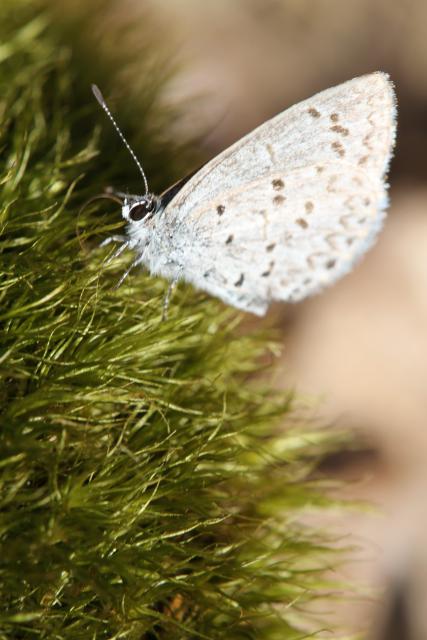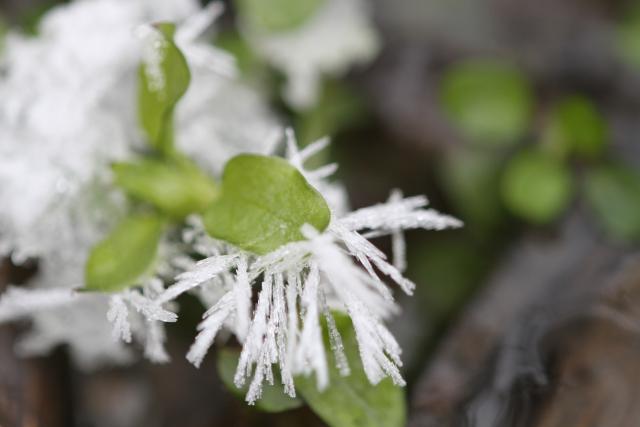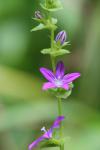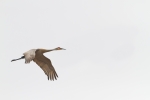macro
Poll: Crab Spider (part 2)
ktuli — Wed, 04/14/2010 - 19:02
If you haven't read part 1 yet, definitely check it out.
I've said this before here, but when you find a subject worth shooting, take your time and work with the subject. I kept over thirty exposures (and took probably twice that many but deleted the completely worthless ones) from a span of over two hours of working with this spider.
Definitely work your subject.
With that in mind, I kept trying different exposure levels. Here are four different exposures - take a look and vote below for your favorite. Despite the great variance in the look of these photos, these are straight out of the camera with no post production.

Version 1: 1/5 sec at f/9.1 with pop-up flash. IMG_0998
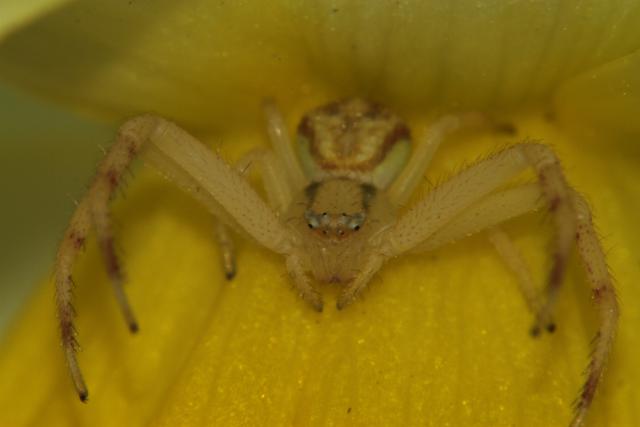
Version 2: 1/10 sec at f/9.1 with pop-up flash and exposure compensation -1 stop. IMG_0999
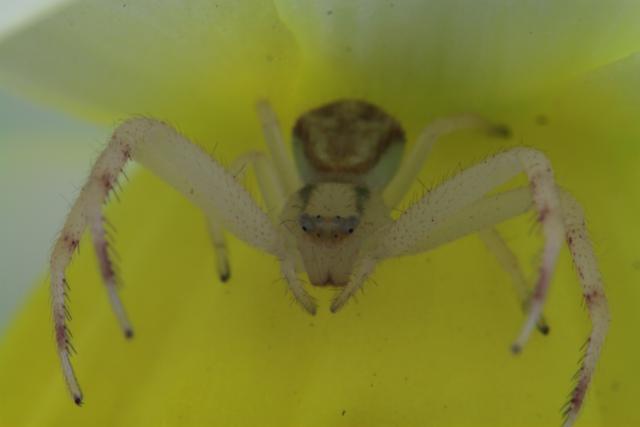
Version 3: 1/3 sec at f/9.1 with no flash and exposure compensation -1/3 stop. IMG_1000
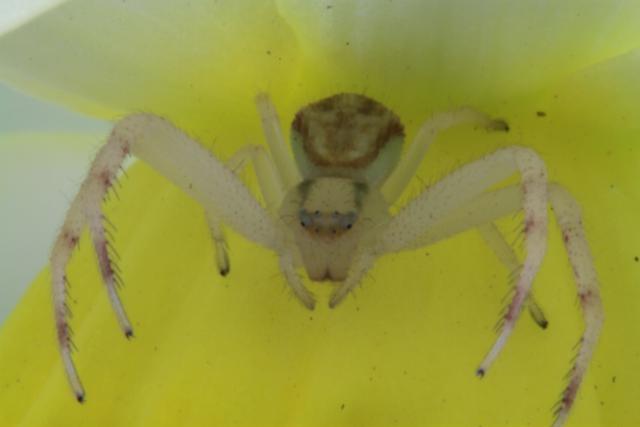
Version 4: 4 sec at f/25.8 with no flash. IMG_1001
Pretty different, huh? If you use tabs in your browser, I recommend opening each image in a different tab (usually control+clicking the link) and switching between the tabs to see the distinct difference between the images (scrolling through them sometimes makes it tougher to compare.
General Technical Data:Canon EOS 7D, Tamron 180mm f/3.5 Di SP LD 1:1 Macro with Kenko Teleplus PRO 300 "DG" AF 2x Teleconverter for effective 360mm with 68mm in extension tubes. ISO 200. No post production.
One of these will definitely be submitted to a couple upcoming contests. I just need to figure out which one I like best.
What do you think? Vote below, and then leave a comment and let me know why you chose the version you did.
- Bill
Crab Spider (part 1)
ktuli — Tue, 04/13/2010 - 20:36
I've seen photos of crab spiders before, and I've always thought they were awesome spiders. When I found one in our own garden, I was amazed. I spent the better portion of the evening photographing it.
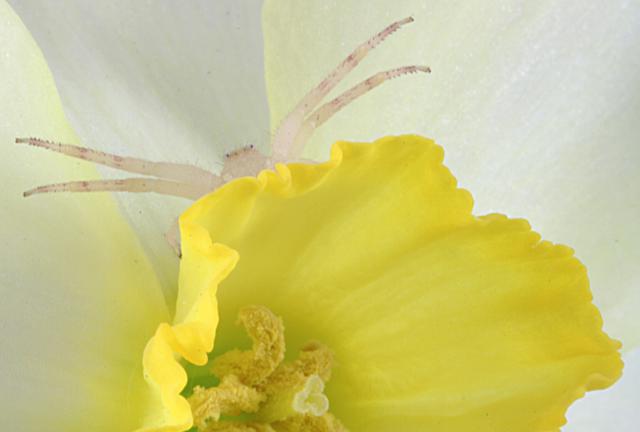
Technical Data: Canon EOS 7D, Tamron 180mm f/3.5 Di SP LD 1:1 Macro with Kenko Teleplus PRO 300 "DG" AF 2x Teleconverter for effective 360mm. 1 second at f/28.1. ISO 200. Post Production: Sharpen 100% 15 pixels, cropped (original).
Why This Photo: This is the first crab spider I've seen, so I took as many photos as I could. It was fairly aggressive and would posture like this whenever loud noises or quick motions happened. I wanted to try and capture that aggressive posturing.
What Works: I did some of the things I've been meaning to try and keep in mind with my macro work. The kind of stuff I did to try and make this photo better include:
- Used a tripod
- Smaller aperture for greater depth of field
- Timer delay (since I still don't have a remote trigger)
- Live View with zoom for better focusing
- Generous framing to allow for cropping if necessary
What Didn't Work: I wasn't thrilled with the framing, but since I left enough room, I was able to crop it down to something I liked more. The image was a bit out of focus, but I was able to sharpen it a little in Photoshop. I keep debating the exposure levels, feeling that the image is a bit blown out, but haven't been able to adjust the levels in Photoshop to my liking - though the cropping removed some of the problem by removing some of the extra areas of white flower pedals.
Working on these photos helped me to feel like I've come along way and have started to put some of the things I've learned into practice. At the same time, they's showed me how much more I have to learn.
What do you think? How did I do with this very special subject to shoot?
- Bill
Moth and Moss
ktuli — Sun, 04/11/2010 - 20:01
Anya and I took another trip out to Deer Lakes Park to see what we could find to shoot. I was mainly looking for more macro photos.
As we walked along, I saw this small bright blue moth fluttering around. I tracked it for a few minutes, then managed to pick it up. This isn't something I do too often, as I try to not impact anything I photograph, but I figured if I could be careful enough to not injure the moth, it would be ok. Maybe this is a technique I can work on improving and using to my advantage.
Once I managed to catch the little guy, he actually seemed very willing to hang out, easily moving from hand to hand if I just put another finger in front of him he would walk up onto it. After looking around for a bit, Anya found a small clump of moss that would work great as a backdrop.
As I held the moth, I noticed his proboscis was scanning over my hand, and I decided I wanted to try and photograph that. Luckily, he continued to search through the moss with his proboscis the same way.
Technical Data: Canon EOS 7D, Tamron 180mm f/3.5 Di SP LD 1:1 Macro, 1/170 sec at f/8. ISO 200. No post production. Deer Lakes Park, Tarentum, PA.
Unfortunately, I didn't do such a great job of getting the shot I wanted. There were a few things I had in mind while taking these photos - some improvements I wanted to make, some things I wanted to try. But at the same time, there where are a couple of things I did wrong, and some things I simply forgot.
- Hand-held Shooting: This is a bad habit that I think I need to break sometime soon. I am not a big fan of the tripod we own (I've been telling myself for a while we need a new one). However, I rarely carry a tripod with me when I head out into the field. I sometimes get away with it, but today was not one of those days.
- Smaller Aperture, Slower Shutter Speed: I've been looking at some of my macro photography, and I'm starting to wish I had used a smaller aperture to capture more depth of field. So today was when I thought to try that. The photo here was shot at f/8. Combine that with my reluctance to carry a tripod, and you increase your chances of blurry photos.
- Poor Framing: This photo is only one out of ten that did not cut off any part of the moth. This is something I'm rather disappointed in myself with. Granted this is something that is easy to do with macro where any movement is exaggerated. But that's really no excuse, I simply wasn't taking the time I should have been to get things lined up.
All in all, I came away with a fairly disappointing set of photos, but some important reminders about things I need to keep in mind when out taking photos. Hopefully next time out, I can work on the juggling act that is remembering all the pieces that need to come together to be able capture that remarkable image.
Have any suggestions for things I could do to improve these photos? Or have any questions about the things I did right or wrong with my shots? Or just want to commiserate about the struggles of macro photography? Leave me a comment and let me know what you think.
- Bill
Aphids on Rosebud
ktuli — Tue, 04/06/2010 - 19:43
I submitted this photo to the Photographic Section's second digital projected image competition of the year.
I really liked this photo. Unfortunately, it didn't do so well in the judging.
Technical Data: Canon EOS Digital Rebel XT, Tamron 180mm f/3.5 Di SP LD 1:1 Macro, 1/250 sec at f/4. ISO 400. No post production. Taken in our backyard.
Why This Photo: I originally was in the yard photographing an insect I had never seen before (but turned out to be a ladybug larva and I'll share some of those photos eventually) when I saw this rosebud covered in aphids. I steadied the lens by leaning against our fence and squeezed off as many photos as I could.
What Works: The focus is tack sharp, and the shallow depth of field produces a perfectly blurred background providing a soft green background. The rose sits on one of the thirds lines with the lean of the rosebud is towards the center of the photo keeping the viewers attention from wandering.
What Doesn't Work: I honestly don't think there is much wrong with this photo. I didn't agree with any of the critiques this photo received at the competition, and since I can't think of any I'll just leave it open.
I did remove the sensor dust spots in the version I submitted for competition. That would be the two dark spots on the left side of the photo. We've since cleaned the sensor on our camera to remove future occurrences of that.
What do you think? Is this photo as strong as I think? Or can you find things you don't like about it?
Leave me a comment and let me know what you think.
- Bill
Here Come the Spiders!
ktuli — Thu, 03/11/2010 - 21:58
This is one of my favorite photos. I've submitted this image to multiple compeitions. Most recently, it has been accepted into the The Photographic Section's 2010 Annual Photo Salon for its traveling gallery, and for final judging in George W. Glennie Memorial Nature Salon 2010.
I've been waiting to share this photo since I didn't want to use up all my best photos too quickly. But I figure now is a good time...

Technical Data: Canon EOS Digital Rebel XT, Tamron 180mm f/3.5 Di SP LD 1:1 Macro, 1/100 sec at f/5.6. ISO 400. No post production. McConnell's Mill State Park, Lawrence County, PA.
Why This Photo: I love macro photography. Given the chance, I'll shoot something tiny like this little jumping spider over most other photography opportunities nine times out of ten. The story of this is kind of amusing and I'll give more of it a bit further down.
What Works: Focus is dead on right on the spider's eyes. The catchlight in the spider's eyes is a nice effect. The composition, including the slight tilt work well also.
What Doesn't Work: The depth of field could have been a little deeper and focus could be a tad sharper.
This shot was taken hand-held. I don't think I had a tripod with me that day that would have been able to support the camera with my Tamron macro lens attached. Besides, this spider was crawling around on a wooden railing right at the mill at McConnell's Mill State Park.
Remember what I said about preferring macro over almost every other style of photography? I was sitting on the ground by the railing overlooking Slippery Rock Creek Gorge, right next to the gristmill, and just upstream from a very picturesque covered bridge. There were plenty of people coming and going on the overlook, all of them quickly snapping shots of the stream, mill, and/or bridge and then wandering back off.
Most everyone either ignored me or just gave me a glancing confused look wondering what in the world I could have been taking photos of. Only one person asked what I was so interested in, and thought it was pretty amusing that I would be focusing on such a tiny little spider.
With the weather warming up, I'm looking forward to things like spiders appearing again and giving me something to shoot. I saw a tiny tiny spider on my walk home from the T yesterday, and I was so excited by that.
I know - I'm weird. But either way, what do you think of the photo? Leave me a message and let me know.
- Bill
Getting Back to Normal
ktuli — Tue, 03/02/2010 - 20:29
As promised, I'm trying to get back on my normal routine. What would be nice is if all this snow outside would finally melt and everything else could start getting back to normal.
I keep waiting for things to start really melting. I keep shoveling out the parking spaces in front of our house.
Eventually it all will melt...
And when it does, I think things like this will start appearing.
Technical Data: Canon EOS Digital Rebel XT, Tamron 180mm f/3.5 Di SP LD 1:1 Macro, 1/400 sec at f/5. ISO 400. No post production. Taken in our own backyard.
Why This Photo: Anya does such a great job with the flowers and plants in the yard, and that gives me plenty of subjects right within reach any time I want. So I was probably just out in the yard wandering around and decided to take a photo of this flower (Anya will have to comment to let everyone know what kind it is).
What Works: Focus is tack sharp right where it needs to be, and soft throughout the rest of the photo. Depth of field is almost perfect. Composition is pretty strong. Color representation and exposure levels are very well done.
What Doesn't Work: Honestly, there is very little that I find "wrong" with this photo. Perhaps the center of the flower should be a little lower in the frame to land closer to one of the hot spots at the convergence of the thirds.
I can't wait for flowers and bugs and all that stuff that comes with spring to show up soon. I love wandering around our yard - usually with the macro lens attached - taking photos of things I see almost every day but being able to present them in very different ways.
Maybe that's the lesson I should learn from this photo. Maybe I need to just look a little differently at my current surroundings (even if they are covered in snow) and find something to look at from a whole new perspective to make something mundane into something exciting.
Leave me a comment. Let me know what you think of this photo. Let me know any tips/hints you have for finding that new perspective to look at things from a fresh view point. Or just commiserate about how you're tired of all this snow too... And then scroll down further and vote on the photoshop job on the dive photo.
- Bill
PS: Oh yeah - new lens should be here tomorrow! So exciting!
Dragons and Depth of Field
ktuli — Thu, 02/18/2010 - 21:19
Time for another episode of "What Hangs on Our Walls at Home!"
For our first anniversary, Anya surprised me by having her parents setup a set of eight photos we had taken on the wall above my desk in our office. Each one was of a different animal from our various zoo trips (which we're hoping to resume as a hobby this spring/summer).
While the subject of this photo was something rather mundane to us at the time - after owning a pet store for about two years, Bearded Dragons aren't really anything exotic to us - what this photo lacks in an exotic subject, it makes up for two fold by being such an engaging image! In particular, by using the depth of field to its advantage.

Technical Data: Canon EOS Digital Rebel XT, Canon EF-S 18-55mm f/3.5-5.6 II at 42mm, 1/40 sec at f/5, ISO 400. No post production. National Aquarium in Baltimore, MD.
Why This Photo: I have to be honest and say that I am not 100% certain who took this photo, but the naturally curious behavior of the bearded dragon presented an obviously wonderful photo that I'm sure neither Anya nor myself could pass up.
What Works: Composition is rock solid with the dragon's face sitting perfectly on one of the hot spots for the rule of thirds. But the depth of field is what really makes this photo (I'll discuss it more below).
What Doesn't Work: The exposure in the top left of the photo is a little blown out, but somewhat offsets the dark areas in the bottom right. The focus is the tiniest bit soft (blurry) and would not work for a large print of the photo, but works just fine for the 8x12 print that hangs in the office at home.
So what is all this talk about depth of field? What the heck is depth of field, anyway?
Depth of Field is simply the amount of the photo that is focus. Perhaps some day I'll get into more about what actually causes depth of field, but today we'll talk in non-technical terms. Basically, in this photo, the head and face (and most of the beard) of the dragon is in focus. Everything else is blurred - the rocks in the background, even the dragons leg and tail that are visible. This is referred to as a shallow depth of field - when only a small portion of the photo is in focus.
Which begs the question - why would anyone want a shallow depth of field? Why wouldn't you want everything to be in focus so you could see all the details?
Well, honestly that question is one of personal preference, but in general I feel it is best used as a way to keep the viewer's attention on just the areas of the photo you have in focus. In this case, we wanted to accentuate the face of the dragon.
This can be done one of two ways. You can either completely blur the background so that nothing is recognizable or you can just blur everything that is only needed for context, but not blur it so much that it become unrecognizable.
The trick here is figuring out which to use. In this case, we want to provide the context to keep the viewer looking around this photo, but to keep coming back to the dragon's face. Since most of us know what a lizard's body looks like, the detail is not necessary in the leg and tail, but having it within the frame provides most context to make the viewer more comfortable. I guess a disembodied lizard face would be pretty discomforting to a lot of people... Or the other alternative would be a close-up of just the face of the dragon, which would not be the same kind of photo and might not be as engaging.
Instead, we use the depth of field to help direct the eyes of the viewer to the face of the bearded dragon, but because the blur is not so much that it makes things unrecognizable, the eyes of the viewer are free to wander through the rest of the photo to achieve the context of the photo.
So hopefully that helped explain a bit about why you would want to use depth of field to your advantage. I'm sure I'll have many more examples in the future, so if I did a poor job of explaining and just made you more confused, drop me a comment and let me know so I know what to do better next time.
- Bill
Shutter Envy
ktuli — Wed, 02/03/2010 - 21:48
This photo was taken by my wife, Anya. It is one of my all time favorite photos.
I thought maybe I should wait a little longer to use this one, but I just couldn't wait.

Technical Data: Canon EOS Digital Rebel XT, Tamron 180mm f/3.5 Di SP LD 1:1 Macro, 1/500 sec at f/7.1. ISO 250. No post production. Phipps Conservatory, Pittsburgh, PA.
Why This Photo: I can't really say why Anya took this photo, but I'm really glad that she did. Like I said, it is one of my all time favorites!
What Works: Almost everything. The composition is rock solid, the depth of field is perfect. I know this was taken outdoors in some pretty bright sunlight, and the way the light plays across the flower is mesmerizing.
What Doesn't Work: The focal plane is just a smidge close. It looks like it focused just a tiny bit before the main part of the flower. But I also know that this shot was taken handheld, and I'm really stretching to be able to find something "wrong" with this photo.
We have this photo printed and framed in our house. I've used it as my wallpaper on my computer and cell phone.
I don't think I'll ever get tired of looking at this photo. And each time I look at it, I remember all the great photo trips Anya and I go on and look forward to the next one (which should be coming up here soon for my birthday).
It is shots like this that make me think that we should sell prints. What do you think? Would you pay for a framed copy of this photo?
- Bill
Your Turn #1
ktuli — Fri, 01/29/2010 - 21:21
Ok - different twist today. Today I'm just going to provide a photo and the technical data, the rest is left to you.
Leave me a comment and tell me what you think works and what doesn't work. Easy as pie. (mmmm - pie.)

Technical Data: Canon EOS Digital Rebel XT, Tamron 180mm f/3.5 Di SP LD 1:1 Macro, 1/500 sec at f/6.3. ISO 320. No post production. Franklin Park Concervatory, Columbus, OH.
If you need a full size version to properly critique the photo, when you click on the photo it will take to you my gallery page for the photo. From there, the right most icon in the top center of the photo will provide a full size version.
I really look forward to seeing what folks think about the photo!
- Bill
New & Improved
ktuli — Wed, 01/20/2010 - 21:02
Well, I've been working on the blog pretty much every night, but without new posts, there isn't really much to show for it. First, let me explain what improvements have been made. Comments are now turned on for anonymous users - I debated for a long time about this to keep the site clean of spam, and decided that with a captcha and administrative approval of comments, that it would be ok. If things go well, perhaps I'll turn off the need for approval or find other mechanisms to keep it safe without the need for approval. Also, you'll notice a new logo up top - I'm still up in the air whether I'll keep it for good, but the more I look at it, the more I like it. The logo was made by my friend Douglas over at WeakNetLabs - Thanks Douglas!. I pulled the random gallery images offline for now, and will continue working on getting them back up in some form since it seemed like folks liked that feature. Those were the major improvements (at least the ones that people will see), and I have a bunch more in the pipeline, so keep checking back to see them.
And now onto today's photo:
Technical Data: Canon EOS 7D, Tamron 180mm f/3.5 Di SP LD 1:1 Macro, 1/330 sec at f/3.5. No post production. Cedar Creek Park, Westmoreland County, PA (thanks to Tony for suggesting I provide location details)
Why This Photo: Well, I continued the nerdy cleverness here too. I figured a post with the title of New & Improved would work well for one of the first images taken with my new camera. I was out wandering around on a frigid afternoon in Cedar Creek Park, and I spotted a waterfall and some plants with berries up on a hillside, and as I made my way towards that I found these delicate little plants with these very interesting ice crystals on them. So I stopped and took a few quick shots.
What Works: I feel this is a good use of depth of field with a nice soft background, and the fact that there is sharp focus despite being handheld with macro lens is nice. This is a great example of spotting of an interesting subject - these plants and ice crystals were tiny, and considering I was already making my way to another subject I had spotted, I could have just as easily passed right over these if I didn't have my eyes open.
What Doesn't Work: My impatience got the best of me here. I had a very interesting subject right in front of my lens and instead of stopping and really working with this subject, I only took a few quick shots and moved on. I feel the angle of this shot (and the others I captured) do not show off the intricateness of the ice crystals as I had wanted. I should have taken the time to look at this subject from multiple angles and taken my time with a shot. I could also have taken the time to setup a tripod or at least used the monopod for even sharper focus. (Granted this was found in a fairly wet marshy area, and I wasn't too keen on kneeling in the water much longer, I could have improvised something and spent more time here). Especially in this case where I rushed off to another subject that wasn't going anywhere (if I were tracking some wildlife, it might be different), it is disappointing knowing I got sub-par shots because I was impatient.
What do you think? I'd love to hear other folks' critiques of my photos, feel free to leave a comment with your opinion - it doesn't matter whether you're critiquing it from a technical photography standpoint, or just giving your gut reaction to the photo. I'm hoping to be able to learn from the comments and opinions I gather from this blog.
I'm going to try and stick to a Mon/Wed/Fri schedule with posting, so stop back soon to see what else I can come up with.
- Bill

